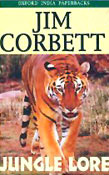The story `Jungle Lore` is wonderfully named as this contains the full meaning of the story. Lore means traditionally transmitted stories and so jungle lore means the stories of the jungle. This is beautifully named by the author Jim Corbett. The name itself tells the inner content which is full of exciting stories about the jungle and its man-eaters.
The original name of Jim Corbett is Edward James. He was born of Irish ancestry in the town of Naini Tal in the Kumaon foothills of the Himalayas. Jim was the eighth child of Christopher and Mary Jane Corbett. His parents had moved to Nainital in 1862. Jim Corbett`s father Christopher Corbett had been appointed postmaster of the town. Jim studied at Oak Openings School, St Joseph`s College and the Diocese Boys School in Naini Tal. This college was later renamed as Sherwood College. After completing high school, he joined the Bengal and North Western Railway, initially working as a fuel inspector at Manakpur in the Punjab, and subsequently as a contractor for the transshipment of goods across the Ganges at Mokama Ghat in Bihar. Jim Corbett was a hunter and fishing enthusiast in his early life. But in later days he was intereted in photography. As his admiration for tigers and leopards grew, he resolved never to shoot them unless they turned man-eater or posed a threat to cattle. Between 1907 and 1938, Corbett tracked and killed lot of man-eaters. These man eaters almost killed 1500 men, women and children in their tenure. His very first success, the Champawat Tiger in Champawat, alone was responsible for 436 documented deaths. He was a very competent hunter but never wasted his talent on innocent animals.
Synopsis:
 `Jungle Lore` by Jim Corbett is a sort of autobiography. The book contains the upbringing and childhood part which is very interesting. As it progresses, like other books of Jim Corbett`s the `Jungle Lore` also concentrates on the minute information about jungles, animals, classification of species. It is also related to hunting story. The best thing about the novel apart from its length is that this book is informative as well as educational. This autobiography seems to be best suited for Jim Corbett, as he has written what pleases him. Tiger and leopard hunting seemed to be Jim Corbett`s passion. A major part of this book is devoted to this topic only. It narrates elaborately how he killed those man-eaters. And those adventures, which not only provided information about birds and snakes initially but also, assisted the reader in getting hooked. In this book, one sees the love affair Corbett has with the wildlife of the Himalayas. Corbett had immense knowledge of the plants and animals of the Himalayas and he gave all the information in this book in best possible way. But still, he believes that he had absorbed only a little from the `book of nature`. He used to roam in the jungles of Shivalik armed with a catapult. He was always fearless of tigers and other wild animals. In this book, Corbett indirectly indicates that today Man is `killing` Mother Nature. A unique part of this book is that everything Corbett learnt are not presented as thrilling episodes but as chapters. Corbett presents numerous incidents related to the theme he is talking about. In some chapters, he teaches us a few things, like examining girth of a snake, pug marks etc.
`Jungle Lore` by Jim Corbett is a sort of autobiography. The book contains the upbringing and childhood part which is very interesting. As it progresses, like other books of Jim Corbett`s the `Jungle Lore` also concentrates on the minute information about jungles, animals, classification of species. It is also related to hunting story. The best thing about the novel apart from its length is that this book is informative as well as educational. This autobiography seems to be best suited for Jim Corbett, as he has written what pleases him. Tiger and leopard hunting seemed to be Jim Corbett`s passion. A major part of this book is devoted to this topic only. It narrates elaborately how he killed those man-eaters. And those adventures, which not only provided information about birds and snakes initially but also, assisted the reader in getting hooked. In this book, one sees the love affair Corbett has with the wildlife of the Himalayas. Corbett had immense knowledge of the plants and animals of the Himalayas and he gave all the information in this book in best possible way. But still, he believes that he had absorbed only a little from the `book of nature`. He used to roam in the jungles of Shivalik armed with a catapult. He was always fearless of tigers and other wild animals. In this book, Corbett indirectly indicates that today Man is `killing` Mother Nature. A unique part of this book is that everything Corbett learnt are not presented as thrilling episodes but as chapters. Corbett presents numerous incidents related to the theme he is talking about. In some chapters, he teaches us a few things, like examining girth of a snake, pug marks etc.
Oxford University Press, USA is the publisher of `Jungle Lore` by Jim Corbett, which is his autobiography narrating the dreadful stories of jungle.
`Jungle Lore` by Jim Corbett is the tale of his hunting in indian jungles. Jungle Lore reveals some of his untold part of life. His life-long passion for the people, jungle, and animals of the Kumaon hills in the Himalayan foothills are clearly depicted in the story. He was an excellent writer and this autobiographical story repeats the same tradition.



















